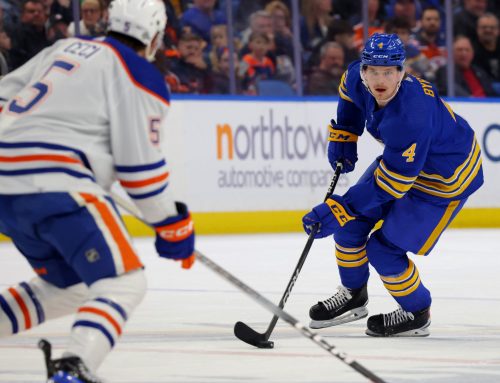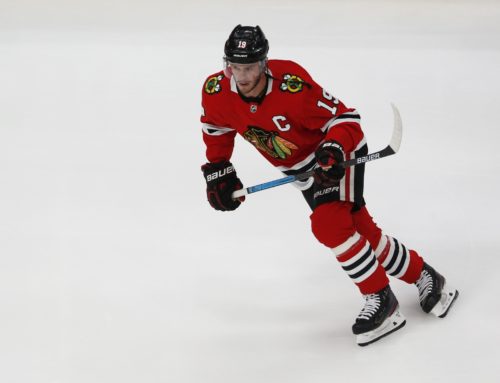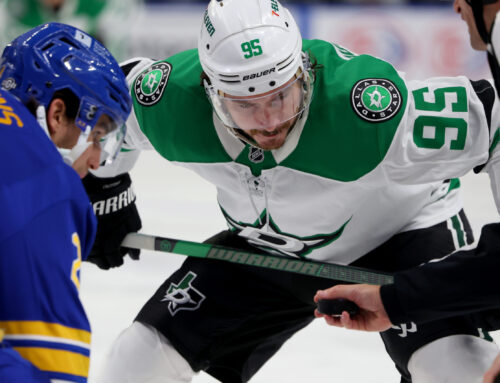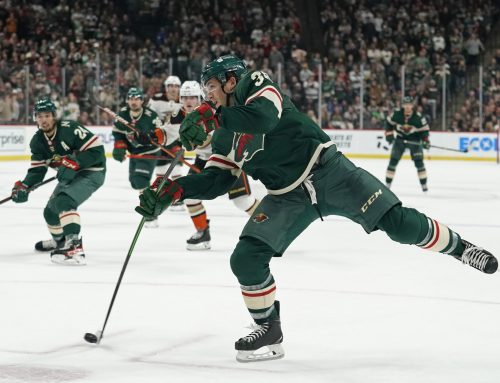
The San Jose Sharks are incapable of having a slow-paced series, or even a slow-paced game. They had leads of 2-0 and 3-1 in Game 3 against St. Louis but the Blues scored three goals in about 14 minutes to take a 4-3 lead. Who else but Couture would tie the game late to send us to overtime.
It certainly wouldn’t be the 2019 NHL Playoffs if we didn’t have a controversy. Just over five minutes into the extra frame, Timo Meier committed a clear hand pass in the offensive zone to Gustav Nyquist, and then Nyquist passed to Erik Karlsson, who sealed the 5-4 win. The hand pass was missed by all the officials and it is not a reviewable play. It’s not like it was a sneaky play either, as Meier full swiped at the puck. It was a pretty wild scene in St. Louis as the refs were discussing amongst themselves what each of them saw – apparently nothing – while the replay on the scoreboard showed what happened to all the fans. Regardless, San Jose has taken a 2-1 series lead with Game 4 on Friday night.
The kicker to all this: Meier was given an assist on the overtime goal. I mean, rightfully so, but just think about that for a second.
David Perron made his mark on the series with a pair of goals as Colton Parayko had three assists. Parayko had one real nice setup where instead of ditching the puck to the line and creating a battle up high, he held onto the puck on a pinch in deep, drew the defenders, and then dished off. One pass later, and Perron scored.
Joe Thornton had two of the San Jose goals and was looking creative in the offensive zone as he always is. It’s nice to see him play so well even after this many years and all the recent injuries.
There was an unfortunate injury as Vince Dunn was hit in the mouth with a shot just past the mid-point of the first period and left the game. Replays showed him to be bleeding and woozy. There’s no need to post that highlight here, but he did not return to the game and they’re calling it an upper-body injury. It didn’t look good.
*
The rumours had been swirling for a couple weeks now but Buffalo made it official on Wednesday: Ralph Krueger will be the team’s next head coach, filling the vacancy following Phil Housley. Krueger will be familiar to hockey fans as he was the coach for the Oilers during the lockout-shortened season and was also the bench boss for the surprising Team Europe at the 2016 World Cup of Hockey.
Seeing quotes floating around social media, it seems like his former players liked him a lot. They praise his both his preparedness and ingenuity, two things absolutely crucial for any coach to succeed in the long-term. I won’t pretend like I remember Edmonton Oilers systems from six years ago but that his inventiveness was specifically praised is music to my ears. Then again, we had quotes last summer from Dallas coach Jim Montgomery about how he wanted the Stars to play an offensively-driven system and they ended up doing exactly the opposite, so we’ll see how this shakes out.
One interesting tidbit about Jeff Skinner as it relates to Krueger:
Jason Botterill just said on the Instigators that Skinner wanted to know who the coach would be.
— Paul Hamilton (@pham1717) May 15, 2019
If other players like Krueger as much as they’re saying, that information will filter back to Skinner. It certainly wouldn’t hurt his chances of re-signing.
*
Columbus signed 25-year old goaltender Elvis Merzlikins to a one-year, one-way contract. He was originally drafted by the team back in 2014 and has since played in the Swiss league. His numbers look good, but this is a 25-year old “prospect” that has been playing in Switzerland. I don’t know much about him other than knowing his name, so I would encourage readers to go through his Dobber Prospects profile here.
With Sergei Bobrovsky assuredly gone, the starting job is completely up for grabs next year. This is a team whose only goalies currently under contract include Merzlikins, Matiss Kivlenieks, and Daniil Tarasov. I wouldn’t expect the latter two to factor into the NHL situation in 2019-20, so the Jackets will go find more goalies in free agency or via trades. We don’t know where Merzlikins fits in yet, but he’ll certainly be in the conversation.
*
Florida signed second-round pick Aleksi Heopniemi to a three-year entry-level deal. I would read his Dobber Prospects profile to read updates on his career.
I will say this is a player I’m very excited about. Sometimes you hear a player get hyped up – and even for a second rounder, there was a lot of hype – and they don’t live up to your expectations. Whenever I got to watch Heopniemi, which was pretty exclusively the last two World Juniors, he always stood out to me. He’s on the smaller side but that doesn’t worry me at all. He has a wealth of talent and with all the top-end wingers Florida has, he won’t be expected to fill a prime role right away. They can use him on the third line much like Carolina did with Andrei Svechnikov to get him the experience he needs but in a lesser role.
There’s every chance he goes to the AHL to get some experience first but he’s also a guy talented enough to play his way on the roster out of training camp. Regardless, this is an exciting day for Panthers fans – another potential star winger is on his way.
*
I wanted to take some time to talk about Clayton Keller.
There are a lot of reasons why he’s an interesting topic: he’s a highly-touted, highly-skilled top-10 pick; he had a great rookie season on a bad team; he’s ostensibly the offensive leader on an up-and-coming franchise; he’s still very young, turning 21 in July. You can pick any one, or some combination, of the above and come up with a good answer why he’s worth digging into.
A couple days ago I wrote about expectations and Keller was certainly a guy I had high expectations for this year. In standard Yahoo! leagues, my preseason ranking for him was 51st overall, and I had him finishing 19th in total points with 74.75, just a shade behind Mitch Marner. Neither of my expectations ended up being anywhere close to correct.
Let’s take a step back from the 2018-19 season and look at Keller’s career in totality. He only has two full seasons but did play a handful of games in 2016-17, giving him 167 career games. From Hockey Reference, these are all the players since 2005 with 165-plus games played in their age 18-20 seasons and averaging at least 0.6 points per game in the meantime:
Now, the scoring environment for the last couple years has been higher than many years prior, but even when adjusting for the higher-scoring NHL, Keller’s total would still fall in a range ahead of Barkov. And Arizona has been the lowest-scoring team in the NHL the last two years, scoring 2.5 goals per 60 minutes. That rate would have been 25th in the league from 2014-15 through 2015-16. So, yeah, it’s been a higher scoring environment, but it’s not as if his particular team has been good offensively by any measure.
A few weeks ago, I wrote about the coaching staff’s comments about wanting Keller to get to the net more. There may be some merit to what they said, by the way, though I do think at the same time it’s a bit overblown. He could probably stand to get to the crease more often but he’s most certainly not a perimeter shooter. Since it’s already been covered, I’ll skip over all of this and just direct readers to go check out those Ramblings from April. They go into this subject with a (tiny) bit of depth.
There is still a lot going for Keller. First, he’s going to be assured a lot of minutes. He saw his TOI/game actually decline a bit in 2018-19 but he was still over 18 minutes per game, leading Arizona forwards in five-on-five ice time per game. (And that was with declining ice time over the final quarter of the season). Second, he’s still shooting a lot for his age: since 2005, Keller is 1 of 6 players with at least 200 shots in both their age-19 and age-20 seasons. The others are Sebastian Aho, Jack Eichel, Evander Kane, Patrik Laine, and Steven Stamkos. On a per-game basis, over Keller’s two full seasons, his shot rate (2.51 per game) is comparable to guys like Phil Kessel (2.52), Anze Kopitar (2.56), and Sebastian Aho (2.59) when they were in their age-19 and age-20 seasons. Not that Keller is a comparable player to these guys in terms of style, just in terms of what they produced for shots at the same age.
One concern for me is that Keller’s zone entry/exit numbers aren’t very good. I should say that they’re fine, as his percentage of entry/exits with control over the last two years rank in the top third of the league, but he’s nowhere near top-end. Now, it should be said that not many Arizona players who’ve been there each of the last two seasons have great numbers in this regard. Derek Stepan’s aren’t good, Oliver Ekman-Larsson’s are pretty good but not elite, Christian Dvorak’s sample size isn’t really big enough, and the same can be said about the number of tracked games for Christian Fischer. I don’t want to put Keller’s good-not-great numbers all on the team but I think this is very well a case where as the team improves, as will Keller in this regard. It won’t be enough to push him to elite status – he still has a ways to go himself in this area – but it’s a start.
I’m still very bullish on Keller but my expectations have been tempered. Until the team around him makes headway offensively, it’ll be hard to project him for much more than 60 points. I’ll have a better answer once I do my projections in a couple-few months, but this is a situation where both the player and the team need to improve before I get too excited again.
*
While I was looking into Keller’s season, one guy who stood out was Vinnie Hinostroza. He had a wonderful season. When looking at primary points per 60 minutes at five-on-five, his 1.35 per 60 minutes was in the neighbourhood of names like Jakub Voracek (1.37), Anders Lee (1.36), Jaden Schwartz (1.34), and Nino Niederreiter (1.34). Now, some of those players had down years themselves so I’m not comparing him directly, but Hinostroza was also on the ice for only 2.02 goals per 60 minutes at five-on-five. That pales in comparison to the rest of this list as Voracek was over 2.50, Lee was over 2.90, and even in Schwartz’s poor season, he was over 2.30. So while the comparables may have had down years, Hinostroza’s offensive environment was very poor, and worse than the others.
He’s another guy who didn’t have very good zone exit/entry numbers on the Coyotes, but his sample size was too small to really make a judgment.
Among 192 forwards with at least 900 minutes at five-on-five in 2018-19, Hinostroza was tied for 33rd in individual expected goals per 60 minutes with Chris Kreider, Craig Smith, and Tyler Seguin. His shot attempt rate was ahead of Kreider’s, ahead of Sean Monahan’s, and ahead of Jamie Benn’s. As far as trying to generate goals goes, Hinostroza’s season was pretty good.
He only had 39 points this past year but he did that playing 15:16 per night and he only had five power-play points. What if he plays 17 minutes a night next year with even 15 PPPs? This is a guy with the tools necessary for a 20-goal, 50-point season and he’ll be basically free in drafts next year. I don’t think there’s significant upside, but it’s a lottery ticket for good production that brings a decent shot rate and reasonable amount of hits. He’s a guy to definitely keep in mind for 2019-20 in less-shallow leagues.





 CHI
CHI SEA
SEA FLA
FLA DAL
DAL WPG
WPG CBJ
CBJ L.A
L.A BUF
BUF S.J
S.J N.J
N.J VAN
VAN
